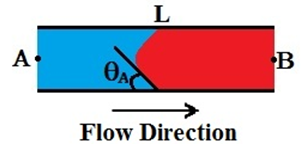Fundamentals of Fluid Flow in Porous Media
Chapter 2
Multi-phase Saturated Rock Properties:
Dominance of Capillary Forces over Viscous Forces
Viscous force is reflected in the pressure gradient generated by the flow through a porous medium. The pressure gradient is proportional to the viscosity and the fluid velocity and inversely proportional to the conductivity of the medium. Viscous force in a circular capillary tube can be found from eq.(2‑17) or:

Where:
- v = fluid velocity, cm/sec
- r = capillary tube radius, cm
- ΔP = pressure loss over length L, (dyne/cm2)
- μ = fluid viscosity, centipoise
- L = length over which pressure loss is measured, cm
As mentioned before for a porous medium, the pressure gradient is given by Darcy’s law.
Now, consider the displacement of oil by water from a capillary tube, at velocity v (Figure 2‑55). For simplicity let us assume that μnw = μw = μ.

Typical values are: μ = 1.0 cp and σ = 30 mN/m and velocity = 0.3 m/d.

Figure 2-55: Flow in a Capillary Tube
Calculated vales of PB – PA are listed in Table 3 for different r’s .
Table 3: Table of Capillary and Viscous Forces for Different Sizes of Radii

Note that the capillary force is much higher than the viscous force and the downstream pressure is higher in contrast to one phase flow that the downstream pressure is always lower than the upstream pressure.
Questions?
If you have any questions at all, please feel free to ask PERM! We are here to help the community.
